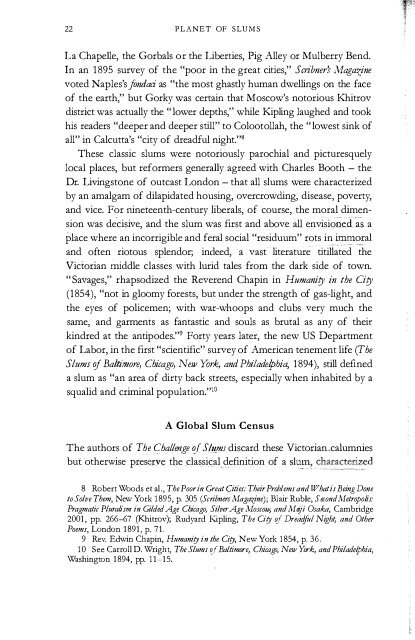Untitled - Rebel Studies Library
Untitled - Rebel Studies Library
Untitled - Rebel Studies Library
You also want an ePaper? Increase the reach of your titles
YUMPU automatically turns print PDFs into web optimized ePapers that Google loves.
22 PLANET OF SLUMS<br />
La Chapelle, the Gorbals or the Liberties, Pig Alley or Mulberry Bend.<br />
In an 1895 survey of the "poor in the great cities," Scribner's Magazine<br />
voted Naples's fondaci as "the most ghastly human dwellings on the face<br />
of the earth," but Gorky was certain that Moscow's notorious Khitrov<br />
district was actually the "lower depths," while Kipling laughed and took<br />
his readers "deeper and deeper still" to Colootollah, the "lowest sink of<br />
all" in Calcutta's "city of dreadful night."B<br />
These classic slums were notoriously parochial and picturesquely<br />
local places, but reformers generally agreed with Charles Booth - the<br />
Dr. Livingstone of outcast London - that all slums were characterized<br />
by an amalgam of dilapidated housing, overcrowding, disease, poverty,<br />
and vice. For nineteenth-century liberals, of course, the moral dimension<br />
was decisive, and the slum was first and above all envisioned s a<br />
place where an incorrigible and feral social "residuum" rots in i111!l1ral<br />
and often riotous splendor; indeed, a vast literature titillated the<br />
Victorian middle classes with lurid tales from the dark side of town.<br />
"Savages," rhapsodized the Reverend Chapin in Humanity in the City<br />
(1854), "not in gloomy forests, but under the strength of gas-light, and<br />
the eyes of policemen; with war-whoops and clubs very much the<br />
same, and garments as fantastic and souls as brutal as any of their<br />
kindred at the antipodes."9 Forty years later, the new US Department<br />
of Labor, in the first "scientific" survey of American tenement life (The<br />
Slums of Baltimore) Chicago) New York) and Philadelphia, 1894), still defined<br />
a slum as "an area of dirty back streets, especially when inhabited by a<br />
squalid and criminal population."lo<br />
A Global Slum Census<br />
The authors of The Challenge of SIu..ms discard these Victorian.calumnies<br />
buf otherwise preserve the classical definition of a sll 1 m, c _ a:rterz _ ed<br />
8 Robert Woods et aI., The Poor in Gre at Cities: Their Problems and What is Being Done<br />
to Solve Them, New York 1895, p_ 305 (Scribners Magazine); Blair Ruble, Second Metropolis:<br />
Pragmatic Pluralism in Gilded Age Chicago, Silver Age Moscow, and Meiji Os aka, Cambridge<br />
2001, pp. 266-67 (Khitrov); Rudyard Kipling, The Ci ty of Dreadful Night, and Other<br />
Poems, London 1891, p. 71.<br />
9 Rev. Edwin Chapin, Humanity in the Ci ty, New York 1854, p. 36.<br />
10 See Carroll D. Wright, The Slums f Baltimore, Chicago, New York, and Philadelphia,<br />
Washington 1894, pp. 11-15.<br />
THE PREVALENCE OF SLUMS 23<br />
by overcrowding, poor or informal housing, inadequate access to safe<br />
--water and sanitation, and insecurity of tenure. This operational defini-<br />
-cion, officially adopted at a UN meeting in Nairobi in October 2002, is<br />
"restricted to the physical and legal characteristics of the settlement,"<br />
and eschews the more difficult-to-measure "social dimensions,"<br />
althoughjt..qu2:tes unger most circumstances to economic and social<br />
marginality.l1 Encompassing peri-urban shantytowns as well as arche-<br />
-typal inner-city tenements, this multidimensional approach is in<br />
practice a very conservative gauge of what qualifies as a slum; many<br />
readers \vill be surprised by the UN's counter-experiential finding that<br />
only 19.6 percent of urban Mexicans live in slums (it is generally<br />
conceded by local experts that almost two-thirds of Mexicans live in<br />
colonias populares or older tenements). Even using this restrictive definition,<br />
the UN researchers estimate that there were at least 921 million<br />
slum-dwellers in 2001 and more than one billion in 2005: nearly equal<br />
to the population of the world when the young Engels first ventured<br />
onto the mean streets of St. Giles and Old Town Manchester in 1844.12<br />
Indeed, neoliberal capitalism since 1970 has multiplied Dickens's<br />
notorious slum of Tom-all-Alone's in Bleak House by exponential<br />
powers. Residents of slums, while only 6 percent of the city population<br />
of the developed countries, constitute a staggering 78.2 percent of<br />
urbanites in the least-developed countries; this equals fully a third of<br />
the global urban population.<br />
According to UN-HABITAT, the world's highest percentages of<br />
slum-dwellers are in Ethiopia (an astonishing 99.4 percent of the urban<br />
population), Chad (also 99.4 percent), Afghanistan (98.5 percent), and<br />
Nepal (92 percent). Bombay, with 10 to 12 million squatters and<br />
tenement-dwellers, is the global capital of slum-dwelling, followed by<br />
Mexico City and Dhaka (9 to 10 million each), and then Lagos, Cairo,<br />
Karachi, Kinshasa-Brazzaville, Sao Paulo, Shanghai, and Delhi (6 to 8<br />
million each).13<br />
11 Challenge, pp. 12 -13.<br />
12 UN-HABITAT executive director Anna Tibaijuka quoted in "More than One<br />
Billion People Call Urban Slums Their Home," City lvIqyors Report, February 2004:<br />
www.citymayors.com/report/slums.html.<br />
13 UN-HABITAT, "Slums of the World: The Face of Urban Poverty in the New<br />
Millennium?," working paper, Nairobi 2003, annex 3.


